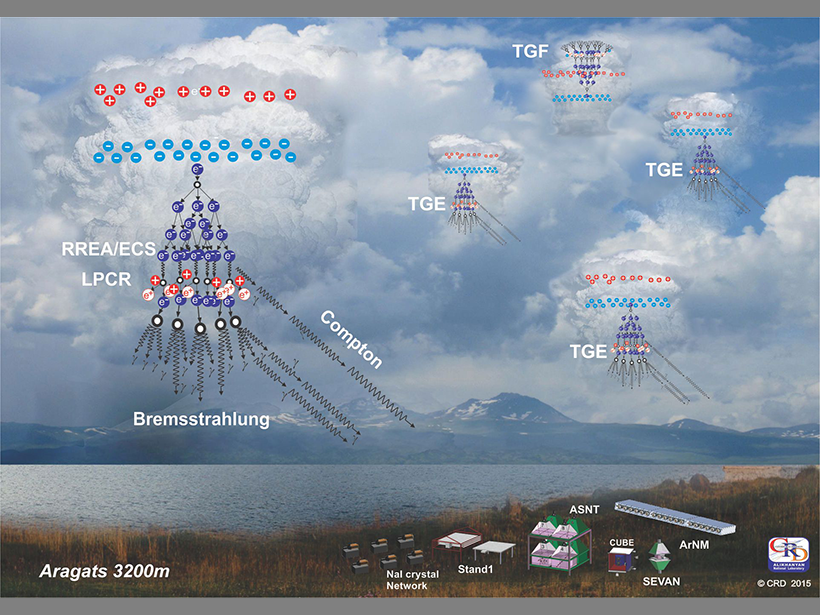One of the biggest mysteries in the atmospheric sciences is understanding how lightning is initiated inside thunderclouds. Thunderstorms are correlated with high-energy processes in the atmosphere, including terrestrial gamma ray flashes (TGF) and sizable long-lasting fluxes of electrons, gamma rays, and neutrons. However, the relationships among thundercloud electrification, lightning activity, wideband radio emission, and enhanced particle fluxes have not yet been established with certainty.
The relationships among thundercloud electrification, lightning activity, wideband radio emission, and enhanced particle fluxes have not yet been established with certainty.
We are particularly intrigued by the relationship between high-energy processes in the atmosphere and lightning initiation and propagation. Synchronized observations of lightning discharges and thunderstorm ground enhancements (TGEs), alternative mechanisms for discharging the atmospheric “electric engine,” help us to understand them better.
To discuss these high-energy phenomena, we held the conference Thunderstorms and Elementary Particle Acceleration at the Nor Amberd International Conference Center of the Yerevan Physics Institute (YerPhI) in Armenia. Thirty scientists and students from the United States, Japan, France, Germany, Israel, Russia, and Armenia attended.
Particle Fluxes, Cosmic Rays, or Something Else?
Presentations focused on such topics as observations and models of high-energy emissions in thunderclouds, the termination of particle fluxes by lightning, multivariate observations of thunderstorms from the Earth’s surface and from space, radio emissions produced by atmospheric discharges and particle fluxes, and the influence of the extensive air showers (EASs) on lightning initiation.
Discussions covered questions that included the following:
- Do particle fluxes initiate lightning?
- Do EASs help to unleash cloud-to-ground lightning?
- Do TGE and TGF currents compete with the lightning current?
- What is the mechanism for particle flux termination?
Observations from Aragats
During the workshop, attendees observed a series of large thunderstorm ground enhancements using new Aragats Space Environmental Center capabilities.
The workshop participants agreed that it would be useful to check the models of particle origin in thunderclouds by comparing the vast amount of experimental data on TGEs observed in Armenia, Japan, Slovakia, Russia, and the United States under various conditions using different particle detectors. Armenian physicists suggested using the sensors developed by other groups at Aragats Space Environmental Center (ASEC), where large TGEs are frequent in spring and autumn.
New fast electronics have recently been installed at Aragats, making it possible to relate lightning initiation to disturbances of the electrostatic field and to particle fluxes on a millisecond time scale. Various particle detectors and fast electric field sensors are now synchronized by GPS receivers, providing time stamps accurate to a few tens of nanoseconds. During the workshop, attendees observed a series of large TGEs using these new ASEC capabilities.

The thunderclouds above the Aragats research station act as a natural “electron accelerator,” initiating several interesting events, which conference participants discussed extensively. During the 7 October TGE, particle fluxes and lightning flashes were synchronized on a millisecond time scale. Using a detailed analysis of the electrostatic field disturbances and particle detector count rates, we can conclude that the particle decline started about 200 milliseconds after strong negative cloud-to-ground lightning.
Presentation slides, proceedings, and discussion videos are available on the conference website, and a hard copy of the proceedings is available on request from the Cosmic Ray Division of the Yerevan Physics Institute ([email protected]). Registration is now open for TEPA 2016, which is scheduled for 3–7 October 2016.
The Cosmic Ray Division of YerPhI and the Skobeltsyn Institute of Nuclear Physics of Moscow State University organized this workshop, and YerPhI and the Armenian State Committee of Science sponsored it.
—Ashot A. Chilingarian, Cosmic Ray Division, Yerevan Physics Institute, Yerevan, Armenia; email: [email protected]
Citation: Chilingarian, A. A. (2016), Where does lightning come from?, Eos, 97, doi:10.1029/2016EO050097. Published on 15 April 2016.
Text © 2016. The authors. CC BY-NC 3.0
Except where otherwise noted, images are subject to copyright. Any reuse without express permission from the copyright owner is prohibited.

